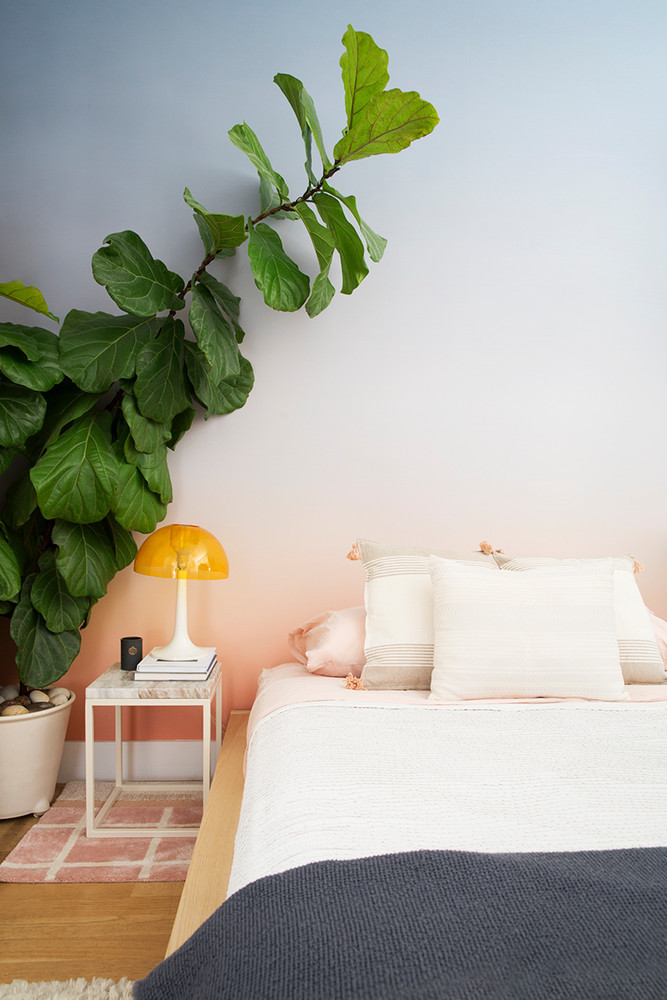We may earn revenue from the products available on this page and participate in affiliate programs.
When it comes to designing the room in which we tend to spend a great deal of our day in, there are a lot of factors worth taking into consideration. Coziness is without a doubt one very crucial element while maintaining a serene and calming vibe come in at a close second. If you have yet to guess, we’re talking about the bedroom, of course. And while it’s fair to say that most people tend to overlook the design of their bedroom—unless you’re in a studio, then you really have no choice but to pay mind to it—it’s one space where a little thought and effort can really go the distance. But before you set out to either declutter yours or fill it with more accents and objects, there is one fundamental detail you might be overlooking: the wall paint.
The paint color of a bedroom can be very telling of a personality, and for as fun as it can be to let your creative side run free, there are instances where it may not be the best idea. Case in point? When you opt for a wall paint so vibrant and invigorating that it, in turn, impacts your sleep. And because losing out on sleep is not so ideal, we set out to uncover the hues that could be doing more harm than good. Ahead, a few trusted experts give us the scoop on the colors you should avoid bringing into your bedroom.
What to Avoid
Stark white

We don’t see the whole whitewashed minimalist movement dying down anytime soon and for those who find themselves compelled to embrace the trend, be wary when looking to integrate it into your bedroom. A brilliant white is wonderful in theory—serene, smooth, and reminiscent of the Santorini skyline—and yet, it has the potential to impact your sleep.
“One thing we would suggest is, if you are going to have white bedroom walls, it can be better to choose a white with some depth and complexity. Stark white can potentially over-brighten a room and keep you up at night,” advises Jamie Davis of Portola Paints. Instead, go for a white that boasts a subtle hint of warmth for a relaxed feel—much like this serene spot, which downplays the intensity of the white with added saturation.
Try: Full Circle, Portola Paints
Yellow

It’s no secret that we have a serious love affair with yellow. The trendy hue is making a splash in the decor world but, think twice before embracing it in the form of wall paint. “We do always avoid bright yellow walls in a bedroom, as it tends to feel too high energy,” note designers Julie Massucco Kleiner and Melissa Warner Rothblum of Massucco Warner Miller. “We like bedrooms to feel more soothing and serene, even if it’s more subtle than the rest of the house.”
In lieu of utilizing the yellow for the walls, bring the hue in by way of a healthy dose of decorative accents—pillows, throws, and wall art, to start. This vibrant Nashville home definitely has the right idea.
Red

You’ve most definitely heard this one before: the color red has no place in the bedroom. According to the designers of Studio Gild, the hue is one that can evoke a feeling of urgency and excitement—the last two sentiments we would care to experience while attempting to wind down in the evening. “[It] isn’t quite right for a space of calm and tranquility, like the bedroom,” note the designers, however, if you feel compelled to decorate with it, moderation is key. “Using a lot of one color in a space can trigger an emotion that you wouldn’t feel if it were used as just an accent color.”
According to Erika Woelfel, color expert and VP of Color and Creative Services at Behr, while hues such as red and yellow should be utilized sparingly, it’s important to recognize the effect of the colors you’re decorating with. “There are no general rules of thumb for what colors should or shouldn’t be used in a bedroom—but there are colors you can use to create certain moods or feelings. It completely depends on how you’d like to feel when you lay down your head, and the purpose your bedroom serves.” And as most of us tend to view reds, yellows, and oranges with a high-energy perspective, it may be better to embrace them in smaller doses.
What to Embrace

Embrace the cooler tones. There’s a reason why ocean blues have the rep that they do. Aside from evoking great feelings of calmness and serenity, the hues bring about a sense of harmony as well. “Colors that conjure the feeling of the ocean and being by the sea or water is universally balancing,” says Rachel Cope, co-founder of Calico Wallpaper. “If you’re in a room that’s bright red, you might perhaps feel more heated and intense or anxious because it’s so warm. But if you’re in a sky blue room, you’ll obviously feel much calmer.”
When it comes to getting a good night’s sleep, Woelfel suggests looking to the dusty blues, soft greens, and light neutrals. “Psychologically, these colors have natural associations with rest and rejuvenation, and can bring about feelings of calm,” she adds.
Try: Wabi-Sabi T18-10, Soft Focus T18-09, and Quiet Time T18-19 by Behr

Discover more ways to make the most of your bedroom:
See the Bedrooms We Can’t Stop Pinning Cozy Cabin Bedrooms and What We Learned From Them These Are the Plants to Keep in Your Bedroom for a Good Night’s Sleep

